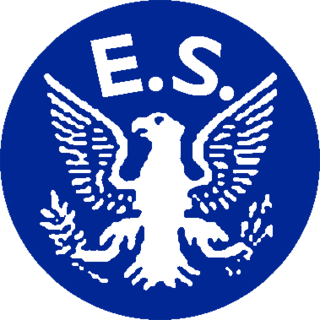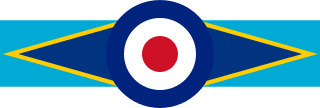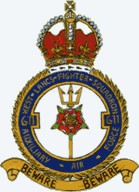
Wing commander is a senior commissioned rank in the British Royal Air Force and air forces of many countries which have historical British influence, including many Commonwealth countries but not including Canada and South Africa. It is sometimes used as the English translation of an equivalent rank in countries which have a non-English air force-specific rank structure. It ranks immediately above squadron leader and immediately below group captain. It has a NATO ranking code of OF-4, and is equivalent to commander in the Royal Navy and to lieutenant colonel in the British Army, the Royal Marines, and the US Army, Air Force, and Marine Corps.

No. 1 (F) Squadron is a squadron of the Royal Air Force. It was the first squadron to fly a VTOL aircraft. It currently operates Eurofighter Typhoon aircraft from RAF Lossiemouth.

The Eagle Squadrons were three fighter squadrons of the Royal Air Force (RAF) formed with volunteer pilots from the United States during the early days of World War II, prior to America's entry into the war in December 1941.

No. 303 Squadron RAF was one of 16 Polish squadrons in the Royal Air Force (RAF) during the Second World War. It was the highest scoring of the Hurricane squadrons during the Battle of Britain)..

No. 41 Squadron of the Royal Air Force is currently the RAF's Test and Evaluation Squadron ("TES"), based at RAF Coningsby, Lincolnshire. Its official title is "41 TES". The squadron was formed in 1916 during First World War as part of the Royal Flying Corps and served on the Western Front as a ground attack and fighter squadron. Disbanded in 1919 as part of the post-war draw down, No. 41 Squadron was re-formed as an RAF squadron in 1923 and remained on home service until 1935 when it was deployed to Aden during the Abyssinian crisis.
No. 610 Squadron of the Royal Air Force was a Squadron of the Auxiliary Air Force. Comprising very high quality pilots, often ex-RAF officers and occasionally locally based company Test pilots from companies such as de Havilland and Airwork. Its pilots were initially part timers who would spend their weekends and spare time flying and practising combat manoeuvres. The squadron was named the "County of Chester" and adopted the motto "Alifero tollitur axe ceres"; which translates as "Ceres rising in a winged chariot". Ceres being the Roman Goddess of Wheat, a reference to Chester's Agricultural sector. Its badge contained the image of a garb.

No. 315 Polish Fighter Squadron was a Polish fighter squadron formed in Great Britain as part of an agreement between the Polish Government in Exile and the United Kingdom in 1941. It was one of several Polish fighter squadrons that fought alongside the Royal Air Force during World War II. It was named after the city of Dęblin, where the main Polish Air Force Academy has been located since 1927.

No. 313 Squadron RAF was a Czechoslovak-manned fighter squadron of the Royal Air Force in the Second World War.

No. 302 Polish Fighter Squadron RAF was a Polish fighter squadron formed in Great Britain as part of an agreement between the Polish Government in Exile and the United Kingdom in 1940. It was one of several Polish fighter squadrons fighting alongside the Royal Air Force during World War II.

Air Commodore Alan Christopher "Al" Deere, was a New Zealand fighter pilot with the Royal Air Force during World War 2, and the author of the war memoir Nine Lives.
The Royal Air Force (RAF) and Fleet Air Arm (FAA) had included personnel from outside the United Kingdom from before the beginning of the Second World War and many served in the Battle of Britain in 1940. Many were volunteers from the British Empire, refugees and exiles from German-occupied Europe, and American emigrants.

No. 609 Squadron of the Royal Auxiliary Air Force, originally formed as a bomber squadron and in the Second World War active as fighter squadron, nowadays provides personnel to augment and support the operations of the Royal Air Force. The squadron is no longer a flying squadron, but instead has the role of Force Protection. It is currently based at RAF Leeming, North Yorkshire.

The name No. 68 Squadron has been used for two quite different units, only one of which was strictly a unit of the Royal Air Force. "No. 68 Squadron RFC" was for a time the official British military designation for No. 2 Squadron Australian Flying Corps.

No 501 Squadron was the fourteenth of the twenty-one flying units in the Royal Auxiliary Air Force, the volunteer reserve part of the British Royal Air Force. The squadron won seven battle honours, flying Hurricane, Spitfire and Tempest fighter aircraft during World War II, and was one of the most heavily engaged units in RAF Fighter Command. In particular, the Squadron saw extensive action during the Battle of France and Battle of Britain. At present the unit is not flying any more and has a logistics role as part of No 85 Expeditionary Logistics Wing.

No. 112 Squadron was a squadron of the Royal Air Force. It served in both the First World War and Second World War and was active for three periods during the Cold War. It is nicknamed "The Shark Squadron", an allusion to the fact that it was the first unit from any Allied air force to use the famous "shark mouth" logo on Curtiss P-40s.
No. 145 Squadron was a Royal Air Force squadron that operated during World War I, World War II and the Cold War.

No. 611 Squadron is a British Royal Air Force squadron. It was first formed in 1936 and was disbanded in 1957 after seeing combat as a fighter unit during the Second World War. It was reformed as a reserve squadron in 2013.
Thomas Frederick Dalton-Morgan, was a fighter pilot and flying ace of the Royal Air Force during the Second World War. He flew during the Battle of Britain, and is counted amongst the ranks of 'The Few'.

Wing leader, or wing commander (flying), denotes the tactical commander of a Commonwealth military wing on flying operations. The terms refer to a position, not a rank, although the role was usually taken by an officer ranked wing commander. The position was also distinct from the commanding officer of the wing, generally a higher-ranked officer. The first wing leaders were appointed in 1941, and the position remained in use until the 1960s.
















